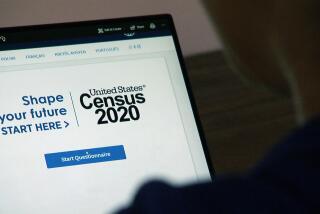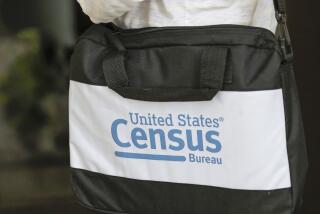We All Need to Come to Our Census
- Share via
I never thought I would accept a job that required an oath of loyalty. But in March, I swore to be both loyal and silent.
After passing a test and completing piles of paperwork, I became a census enumerator by raising my right hand and promising to support and defend the Constitution of the United States against all enemies (please don’t make me enumerate members of the militia in rural Montana). Then I promised never to disclose any information I gleaned on behalf of the Bureau of Census (no tattling on the neighbor who thinks that hubcaps are yard art and that 2 a.m. is when you practice the cymbals).
Becoming a part-time census enumerator was not a career move.
My motives were simple, and craven: I thought it might be interesting to see how well the federal government mobilizes for a countrywide effort to invade people’s privacy; to see how people respond to the front-line workers who want to know how many bathrooms they have; to see if I could explain why the Feds consider “Pacific Islander” a race but not “Hispanic/Latino”; and I thought I might get a story out of it, to enhance my $14-per-hour government wage.
So far, after 16 paid hours on the job as a Census 2000 enumerator, this is what I have learned:
* The screening test is easy if you are able to translate the governmentese. (Despite embarrassingly deficient math skills, I scored 100%.)
* The Feds are to paper as Bill Gates is to silicon chips--otherwise unburdened by either personality or opinion, the proctor at the screening test explained the hefty reliance on forms by intoning repeatedly, “Remember, this is the government.”
* Enumerator training sessions are more disorganized than the management of the Los Angeles Unified School District. To reserve my spot in a training class, I was obliged to speak with four schedulers. Once in the class, we ran out of materials and were given conflicting information.
* Most homeless people are less concerned about remaining anonymous than they are about veterans’ benefits and retaining a captive audience for their strongly held, if sometimes creatively expressed, opinions.
Some things have changed since 1790, when President Washington signed the first census act. Then, the stated purpose of taking a regular census was twofold--to determine a representative composition of Congress and to pay the debt of the American Revolution by dividing it equally among the revolters. Our clever forefathers believed both purposes must be served because if the census were only for determining congressional representation, each state might inflate its numbers to ensure more legislative muscle; if the census served only to initiate the Great American Tradition of tax paying (and its corollary, tax evading), then the count might have been too slim.
In the 22 subsequent census years, the census has served scores of purposes, such as determining private indebtedness, fishery efficiency and who worships what deities and where. While the scope and reach of each decade’s count have reflected the changing realities of a physically, socially and technologically growing nation, they all have two things in common: A primary purpose remains congressional apportionment, and temporary workers are hired to count people, mostly in their own neighborhoods (which, in my case, is not rural Montana but Santa Monica). In addition to thousands of office clerks and other temporary workers, this year the federal government estimates that it will hire 500,000 census enumerators, 20,000 of them in the Southern California/Hawaii region.
Enumerators never forget that this is a federal gig. Bureaucracy rules. I hope I’m not in breach of my confidentiality oath to share how the woman in charge of processing enumerator pay forms addressed our group of trainees: “I’m the OSS. You don’t have the 155s? It’s your responsibility to know which 308s you’ve turned in. There’s a problem with your cert, and I can’t issue a D-155 without a cert . . . to make a change in your D-308. . . . Blah, blah, blah, SF-50Bs, blah, blah, blah, RCC, blah, blah, blah.”
“Your tax dollars at work,” I said to the guy sitting next to me, an actor who used the 30-minute lunch break to audition for a commercial. He replied, “Remember, this is the government.”
I’m guessing Thomas Jefferson never envisioned journalists or actors playing the role of enumerators. As secretary of state during the first census, Jefferson enlisted the aid of U.S. marshals as temporary enumerators. He figured theirs was one of the few civilian agencies with an established field organization. In other words, they knew where you lived. The marshals were paid $1 for counting each 50 people.
In 1790, as today, if you refused to answer census questions, you could be fined; the penalty, $20, was split between the government and the enumerator, possibly creating for a subsequent census a new job category called “bounty hunter.” Today the fine is “not more than $100.” But it is almost never levied. The Feds reckon that because the census is conducted for the benefit of the American people, a punitive response to unresponsiveness is piling it on. Or maybe they realize that people loath to return postage-paid census forms aren’t likely to complete them for penalty remittance either.
Census Bureau spokesman David G. Hendricks recalls only seven cases in which count-averse people were busted. In the 1960 count, National Review writer William F. Rickenbacker lambasted the questionnaire as too invasive, and he refused to play. He was fined $100 and given a 60-day suspended sentence, the appellate court reasoning “the authority to gather reliable statistical data reasonably related to governmental purposes and functions is a necessity if modern government is to legislate intelligently and effectively.”
The same year Victor Sharrow claimed that the census law was unconstitutional, refused to answer and was fined $100. In 1970 five cases were brought to trial. Defendants received fines of either $100 or $50, but a couple of those convictions were overturned on the grounds of selective prosecution.
*
This year, we’re more likely to bribe people than to punish them. In counting homeless people, we enumerators were supposed to be equipped with “hygiene kits,” but, according to our crew leader, our supply of 5,000 zip-lock bags containing toothpaste, razors and mouthwash was stolen from the delivery truck en route to our Westside office. The two or three kits I managed to cadge from another group were received by the homeless with genuine surprise and gratitude. This, I thought, is how the government should be spending my tax dollars.
The final tally for the 1790 census, reflecting the considerable footwork of 650 marshals and their assistants, was 3.9 million people. That effort, which was supposed to be completed in nine months, took two years and cost $45,000, or a bit more than $300,000 in today’s dollars. The budget for the current 10-year census period is $6.7 billion. I wonder how much of that is spent on nose-counters like me and our government-issue Enumerator Training Kits, composed of:
* Z0503 eraser, slip-on, wedge shape, 7510-00-634-5352, one each;
* Z1610 pen, nonretractable, blue, 7520-01-060-8513, one each;
* Z1613 pencil, black, 2000 census logo, one each.
Remember, this is the government.
By the middle of the 19th century the United States had grown and it was a hardship for the marshals to marshal sufficient manpower to enumerate people. In 1880, Congress instituted a system for hiring temporary field and clerical workers from the population at large. It was the first time women were hired and the first time government snoops were required to take an oath of confidentiality. Some 47,000 people went door to door that year and tallied a U.S. population of 63 million.
*
The work of enumerators confirmed, in the 1920 census, that the U.S. population officially had become more urban than rural, and that, in 1950, females in the United States for the first time officially outnumbered males.
By 1960, the Census Bureau was overwhelmed by the enormous need for personnel required to count residents door to door, especially as so few people were home. Astonishingly, it wasn’t until 1970 that census forms were mailed, and enumerators ceased to be the primary means of collecting data. Still, to count 203 million U.S. residents that year, 150,000 enumerators tracked down form-phobic folks who had not returned to sender. The conspiracy between the U.S. Postal Service and the Census Bureau helped define 1980 as the benchmark for the country’s population shift from North and Midwest to South and West. In the last census, in 1990, the U.S. population surpassed 250 million, and as of last year, California claimed 12.15% of the country’s residents.
This year, I’m looking for my share. My enumerating colleagues and I want to talk to you if you care whether your town gets its fair share of subsidized day care or seniors’ programs; whether your congressional representatives understand the social, economic and ethnic composition of their constituents; whether your country has a clue how you want to be defined and described and quantified. So if you didn’t return your census form, sometime before July we’ll be knocking on your door. Because we know where you live. We’re the government.






